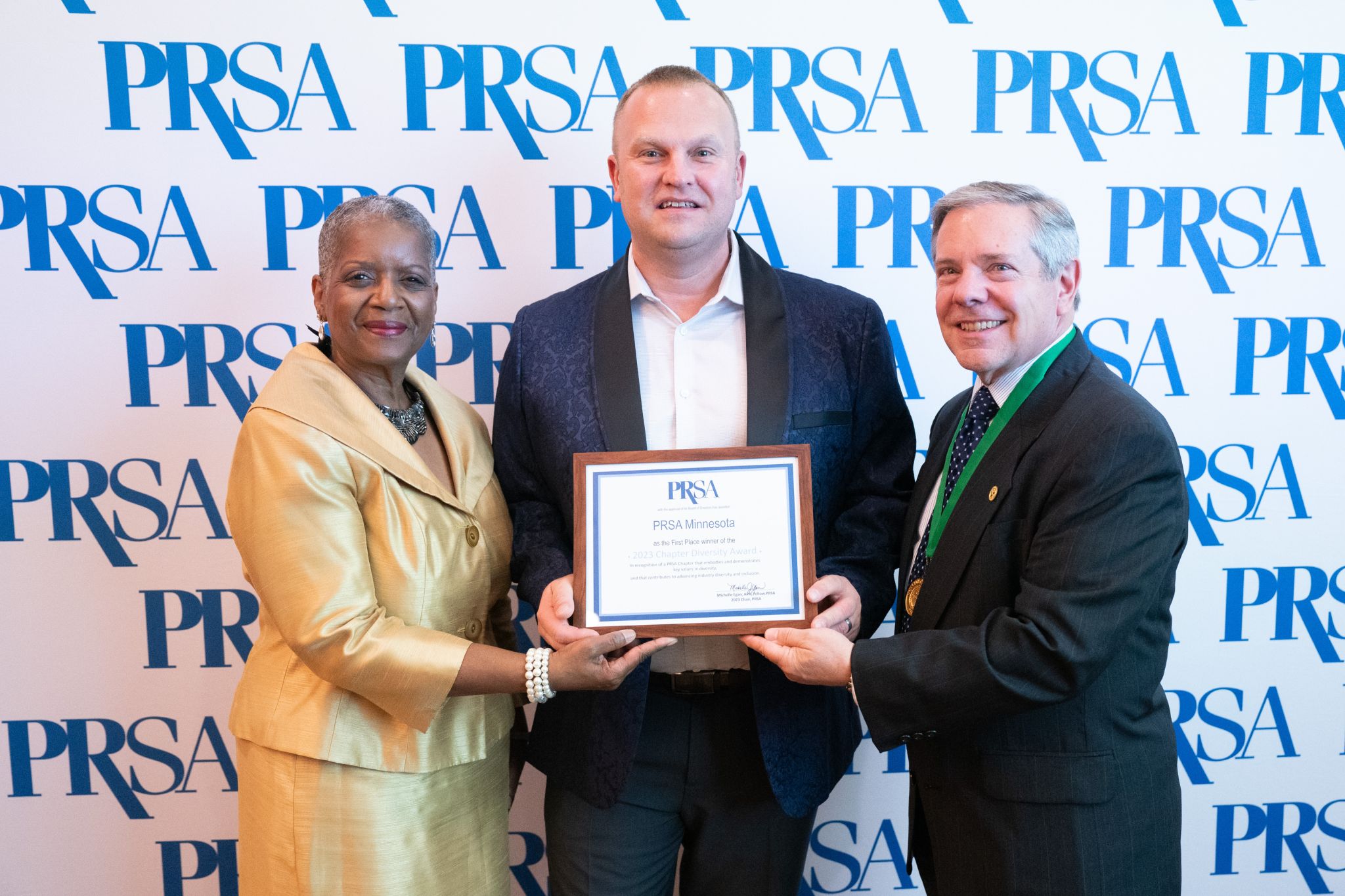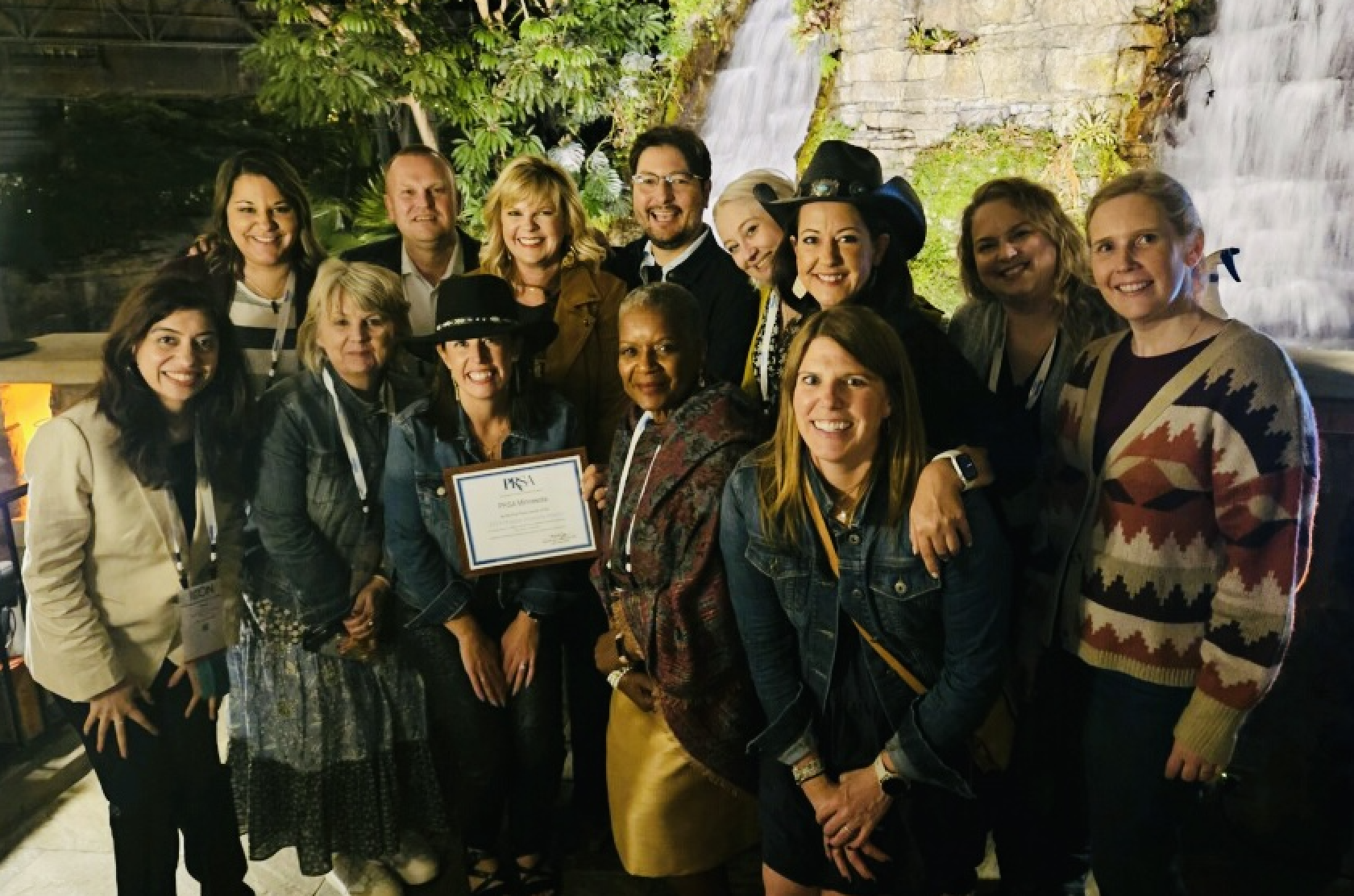This October, six members of the Brandpoint team attended the PRSA International Conference in Nashville, TN. During our three days at the Gaylord Opryland Resort & Conference Center, we met with countless professionals in the PR industry, went to a ton of amazing sessions, ate some delicious barbecue and learned so much about the current and future states of public relations and communications.
I left incredibly energized and excited about what’s ahead for communications professionals in 2024. There’s a lot of scary stuff on the horizon, but a key message was that PR teams are there to be a leader in a sea of chaos, bringing calm and truth in needed times. After compiling notes, reviewing slides and gathering my thoughts, I wanted to share my top takeaways from PRSA ICON 2023.
![]()
The Brandpoint team at PRSA ICON 2023
1. PR and communications pros can be leaders to fight misinformation and a rocky news climate
As we were welcomed to the 2023 PRSA ICON opening keynote, Michelle Egan, the PRSA chair, stated, “There is no more important time to lead.” This call for everyone in the room to put their team, their values and morals, and their audiences first set the tone for the entire event.
From devastating conflict in the Middle East to an upcoming election (more on that later), we remain in a volatile and lightning-fast news cycle with no end in sight to this trend of constant headlines and coverage. There is no longer “business as usual” when it comes to communicating with the public, which means many teams can be at a loss on how to maintain a regular practice while still reaching their lofty business goals.
[Read more: Learn how to create a culture of experimentation in an event marketing world!]
Many sessions and keynote speeches focused on how PR teams often act as the heart and conscience of their own companies. As these leaders, we need to remember to be fully prepared for anything. That doesn’t mean having an emergency plan for any and all news possibility, but more of a set of steps on what to remember and think about when the ship gets rocked again. (And it will get rocked again.)
And don’t forget about misinformation…
As PR practitioners, we need to constantly be thinking of ways to navigate through crises and foster trust. According to a Gallup poll last year, only 34% of Americans trust the news to be fair and accurate. That leaves a lot of people who second-guess or just flat-out don’t believe what they see reported on TV or online.
Breeding trust through transparency, connection with audiences and truly human and relatable stories are all key focuses that PR and communications professionals should always consider. PRSA ICON gave me hope that while there are many bad players in the world who look to spread false information, there are still so many people out there that want to fight that — and I can be one of them.
[Read more: 3 Takeaways for the Next 3 Years for PR Industry!]
2. Diversity, Equity and Inclusion (DEI) is a continued driving force at work
As well as leading organizations in the pursuit of truthful communications in PR campaigns, internal and corporate communicators often find themselves involved with Diversity, Equity and Inclusion efforts as well. There was a huge focus on celebrating DEI at this year’s PRSA ICON, and one thing was clear: DEI is no longer just a “nice to have” initiative in an organization, but a non-negotiable when it comes to creating a brand that’s trustworthy, innovative and recognized.
[Read More: PRSA International Conference: An Interview with Kristi Marquardt and Annette Albrecht of Brandpoint]
Kim Clark of Kim Clark Communications and Anita Ford Saunders, APR, presented an amazing session at the end of the conference focused on social justice messaging and what communicators can do within their organization to upgrade their strategy. They told us it was time to go deeper into these initiatives and that while we’re all still learning, the change in society has happened and there’s no going back — it’s up to us to discover who we are now and how our character will be forged.
Some pieces of advice they gave:
- Think of outcomes instead of “performative fluff” — how can you change the way your organization works rather than doing the bare minimum?
- Create a solid framework based on your policies so your team doesn’t need to reinvent the wheel whenever a new situation arises
- Use the DEPTH model while working on DEI projects: be deliberate, educated, purposeful, tailored and habitual
Congrats to the Minnesota PRSA Chapter!
Another very exciting moment of PRSA ICON was when Minnesota PRSA won first place in this year’s PRSA DEI Chapter Awards. They were recognized in a reception at the event for their work in hosting the 2022 Midwest District Conference and the work they did in 2023 to build their chapter’s cultural competence based on information gathered in the Intercultural Development Inventory. Congratulations!

Marsha Pitts-Phillips, APR, Ben Saukko, APR, MPR, and W. Patrick McSweeny, APR, Fellow PRSA
3. The convergence of PR, marketing, communications and social media is only growing
As I stood in line on day two waiting to load my plate up with some lunch, I found myself facing Sam Sims, APR, current treasurer for PRSA. He asked me how I was enjoying the event and I said, “I have to tell you a secret … I’m actually a marketer, not a PR professional.”
He leaned in and said, “I have a secret, too … we’re all marketers, and we need to make sure everyone here knows it.”
With that all-too-short exchange, I immediately felt validated in my view of what the industry was trending toward, as well as clarity in my own role within my organization.
All these communications-based disciplines are continuing to merge into one cohesive industry. Sure, the tactics and metrics might vary, but the goals are all the same at the end of the day.
PR professionals need to use everything available to them to create effective campaigns. There were sessions at this event about social media strategies, SEO training, leadership and project management, and more. There should be no siloes anymore when creating outward-facing communications campaigns — because our audiences don’t see us as different departments.
[Read More: What PR Teams Need To Do When Economic Uncertainty Challenges Their Efforts]
What should you do about this concept?
There are implications of this convergence, however, and PR professionals need to adopt new skills and techniques to remain competitive. Teams should holistically look at what they can accomplish and see what gaps need to be filled, especially when it comes to what their brands are expecting and what goals they’re being held accountable to, as well. Training, ongoing development, networking and more are all ways that PR and comms professionals can stay up-to-date and fluid during this time in our industry.
The power of a diverse skillset
David Epstein, journalist and New York Times best seller, also spoke during the opening keynote section, and talked about the power of range when it comes to personal development. He spoke of the difference between people who have a strict specialization in their career compared to those who go through a sampling period before settling into their main focus. Having a developmental period is a good thing — even when so many of us feel like we need to decide in an instant what our main focus is.
By testing out different areas of expertise, we are able to build a toolkit that’s an accumulation of everything we’ve learned along the way. This also can provide amazing collaboration opportunities within organizations; different levels of professionals can and should cross-pollinate info by sharing their unique skills and viewpoints in a regular import and export of ideas.
(And by the way, when Epstein mentioned that PR, marketing and social media are all converging, the entire audience applauded.)
4. We’re all a little unsure about what AI means for us
In his Sunday afternoon session, Ivan Pollard of The Conference Board asked, “How can AI augment human intelligence?” His advice is that CCOs and other communications practitioners can use AI to automate the doing in order to liberate the thinking — that said, AI should make us go faster and help us to be more productive so we have more time to do the things only humans can do.
However, the section I found most interesting in his speech was when he touched on the difference between uniqueness and effectiveness. Later that day in a session focused on balancing automation and creativity, Jennifer Poythress of The Rabbit Hole touched on the same thing. So many tasks in the digital world will become streamlined, be it workflow automation or content creation or SEO strategy, that there is a real danger of everything online becoming too similar, too robotic.
“Use AI as a tool, not a crutch,” Poythress advised, and she emphasized letting the technology automate repetitive tasks to allow PR professionals to focus on strategic, creative and empathetic communication. To set yourself apart from this streamlined approach to work, focus on tactics that are uniquely human and can’t be replicated by artificial intelligence, like videos, podcasts and events.
Transparency, transparency, transparency
While all the information I learned was incredible, I find myself most interested in the audience questions at the end of the presentations. Between these previously mentioned sessions, as well as Natan Edelsburg of Muck Racks’ “State of PR: Tech Tools and Social Media,” it was clear — we’re a teensy bit scared of what AI means for us.
[Read More: How Brands Can Build Trust Through Transparency]
Most all questions asked had to do with the ethics of AI and how to truthfully represent their brand’s use of the technology. Jennifer Poythress shared an example of a heartfelt email regarding a school shooting that spawned a minor controversy when the letter ended with “this email was created using generative AI.” Transparency is good, but that backfired … so what do we do?
All of the speakers urged us to take it on a case-by-case basis, but transparency and having a set policy were common themes. Determine what your specific organization’s policy around AI is and communicate often to your internal team. Publish your guidelines on your website and communicate with clients and brands you work with. Be aware of risks, like “hallucinations” created by AI, aka fake information. And remember: programs like ChatGPT are not Google, so you need to factcheck any content generated for you.

The Minnesota PRSA contingency at the conference
5. Be ready for the 2024 elections … like, really ready
In a regular election year, PR professionals and marketers struggle with increased noise in the online space and news and media coverage focusing on the politics at hand. However, there are no more “regular election years,” I’m afraid.
Along with the heightened competition in the news and media online space, the rise of misinformation and an influx of potential crises are at play. PR teams need to emphasize the importance of staying informed and adaptable in the upcoming year to effectively navigate what we’re up against. Professionals in the industry need to expand tactics in order to reach their audiences in trusted ways, whether it’s through paid media efforts or advocacy campaigns.
In the panel session “US Elections Insights,” Joe Libutti of Kivvit and Jeff Lutz of Hart Inc. shared their advice and predictions for the 2024 elections. Takeaways include:
- Crisis communications planning is a must and the phases of a strategy will only increase
- Teams should focus on bias monitoring to analyze any statements to ensure neutrality when desired
- Clients and brands should focus in on their audience’s subcultures to truly connect. Learn their language, find out where they post online and what publications they already read, and use this to communicate to them authentically
- Agility is the name of the game — be ready to activate a campaign or response when a situation arises
- Find different ways to communicate to your audience while the news media is tied up, be it social media or smaller publications
Lastly, teams should have a post-elections plan. Libutti stated that he believes that public perception and expectations of brands and media will shift no matter the outcome of the elections. If Democrats win, opponents will become more vocal and there’s a real probability that blatant misinformation will spread even more rapidly, so brands need to push even deeper on communications strategy to mitigate risks. However, if former President Trump is re-elected, there will be increased angst and the public will look to brands in engage in political conversations and social messaging.
[Read More: 2024 Holiday and Editorial Calendar Downloadable]
If you haven’t started thinking about strategies for your brands in 2024, I encourage you to start now. It definitely isn’t too soon to be thinking about next year’s election season.
Be excited about the evolving industry!
All in all, PRSA ICON 2023 was an incredible time to learn how the public relations world is changing and to connect with people who share the same thoughts, interests and questions as I do. It was so fun to attend sessions, but I had even more fun meeting peers at lunch or before speakers started their presentations. It was a great way to get a feel for how communications and marketing can work together and what I can do as someone who lives in both worlds.
I encourage you to really embrace these changing trends and focus on how you can adapt to grow your own organization or the brands you work with. PR and marketing are always changing and that’s part of the reason why so many of us love working in this industry. I can’t wait to see what other changes are in store next year.



